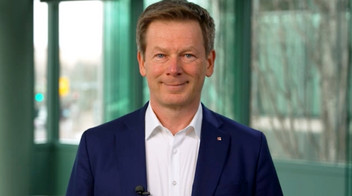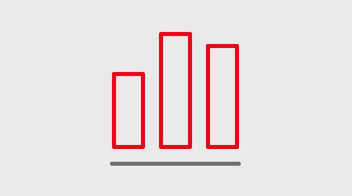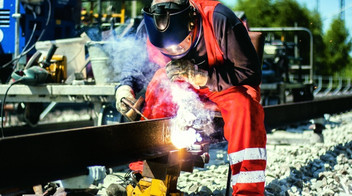Development of the infrastructure
In 2023, about € 16.4 billion was spent for expanding, renewing and maintaining the network, stations and energy facilities. This includes LuFV funds (grants and DB funds) amounting to € 6.8 billion, about € 3.7 billion for maintenance and € 2.3 billion for projects of the requirement plan, as well as funds for the existing network outside the LuFV, such as the Municipal Transport Financing Act (Gemeindeverkehrsfinanzierungsgesetz; GVFG), Digital Rail for Germany or the Climate Action Program, totaling about € 3.6 billion.
In addition, prefinancing of measures by DB rail infrastructure companies (RIC) amounting to about € 2.6 billion are included in 2023. Temporarily, the replacement capital expenditures (for example, to compensate for the inflation effects) and additional maintenance expenses, which also go to the maintenance of the rail infrastructure, are prefinanced with DB funds. These prefinancings are to be replaced by Government funds in 2024.
Key developments in the expansion and renewal of the rail network in 2023 included:
- Fehmarn Belt Fixed Link: The first construction work on the rail connection to the Fehmarn Belt Fixed Link began on Fehmarn in fall 2023. In preparation for construction, nature and environmental protection measures were implemented and construction roads and construction site equipment areas set up. In individual sections of the project, the “rail partnership model” has been used since 2023 as part of the piloting of integrated project implementation for DB projects planned by the Rail Acceleration Commission. All partners involved in the construction work closely together from an early construction phase. The early exchange between DB Group, construction companies, Federal agencies and other partners is intended to bring together expert knowledge for optimized planning and construction in the project at an early stage.
- New construction line Dresden — Prague: The preferred option has been selected. A 30 km tunnel is planned between Saxony and the Czech Republic. In addition, there will also be further capacity-increasing measures between Dresden and Heidenau. The preferred variant for the region was presented on November 20, 2023, after which citizens and public bodies have the opportunity to comment on DB Group’s preferred plan version. The results of the preliminary planning and public consultation are then sent to the German Bundestag (parliament) to undergo “parliamentary inquiry.” Since spring 2023, citizens of the region have had the opportunity in Heidenau to learn about and engage in discussions on the cooperation between Germany and the Czech Republic, the course of the line, the geology and tunneling, via a multimedia
exhibition. - Reconstruction after the flood disaster in the Ahrtal and the Eifel region: In April 2023, the 24 km rail line between Kyllburg and Gerolstein in Rhineland-Palatinate was restored. This involved the renovation of the tracks destroyed during the flooding disaster, as well as nine bridges. At the same time, the construction teams laid many kilometers of cables for new technical equipment and signals. Six modern interlocking modules were constructed. Reconstruction of the section between Walporzheim and Ahrbrück, which was completely destroyed by the flood in the Ahrtal, began in September 2023. The line will be electrified and expanded in the course of these works. By the end of 2025, the line will fully open to traffic again.
- Stuttgart 21: The last of the 28 chalice column supports was concreted at the future through station in June 2023, and the roof of the station hall was finished by the end of 2023. The final tunneling work in the project took place at the airport in September 2023, meaning the project has resulted in a total of about 56 km of tunnels. The work is now focused on the production of the fixed track and the railway equipment.
- Noise reduction on rail tracks: In the Middle Rhine Valley, which is particularly affected by rail traffic noise, DB Group started building noise reduction walls in 20 municipalities at the beginning of 2023. In order to sustainably relieve citizens of rail transport noise, a total of about 27 km of noise barriers are being built in the Middle Rhine Valley. This will make things noticeably quieter for about 22,000 people. A total of more than € 130 million, mainly from Government funds, is being invested for this.
- Second S-Bahn (metro) main line in Munich: On October 31, 2023, the last outstanding plan approval decision was issued by the Federal Railway Authority. A construction permit is therefore in place for plan approval section 3 (east), which comprises the eastern section of the tunnel between Isar and East station. Thanks to the optimized plans in the east section, there will be improved capacity and safety in the future, with fewer adverse effects for local residents during the construction period. The optimizations include the new location of the East station at the Friedenstraße – instead of below Orleansplatz – a new track positioning, and the new emergency and rescue plan. In order to start construction work quickly, the awarded tender for construction work for the east tunnel section with the East station was published in October 2023.
Construction began in 2023 | |
Project name | Project description |
Expansion line Berlin— Dresden |
|
Expansion/new construction line Hamburg— Lübeck — Puttgarden (rail connection for the Fehmarn Belt Fixed Link) |
|
Magdeburg hub |
|
Halle/Leipzig hub |
|
The following requirement plan and GVFG projects were also under construction in 2023:
Projects under construction in 2023 | |
Project name | Project description |
Stelle — Lüneburg expansion line |
|
Expansion line and new construction line Nuremberg— Erfurt (German unification transport projects no. 8.1) |
|
Leipzig — Dresden expansion line (German unification transport projects no. 9) |
|
Karlsruhe — Stuttgart— Nuremberg — Leipzig/Dresden expansion line |
|
Ludwigshafen — Saarbrücken expansion line |
|
Stuttgart — Ulm — Augsburg expansion line and new construction line |
|
Karlsruhe— Offenburg — Freiburg — Basel expansion and new construction line (1st and 2nd construction phase) |
|
Amsterdam— German/Dutch border — Emmerich— Oberhausen expansion line |
|
Frankfurt/Main hub |
|
Berlin hub (Dresdner Bahn) |
|
Combined transport |
|
Hanau — Würzburg/Fulda—Erfurt expansion line and new construction line |
|
Rhine-Ruhr Express |
|
Angermünde — Szczecin expansion line |
|
Uelzen — Stendal — Magdeburg —Halle expansion line (East Corridor North) |
|
Stuttgart — Singen — Germany (Switzerland border expansion line/Gäubahn) |
|
740 m network |
|
Weddel loop |
|
Hamburg hub |
|
Cologne – Aachen expansion line |
|
Cologne hub |
|
Expansion line Knappenrode— Horka |
|
Rhine-Main S-Bahn (metro) |
|
Rhine-Neckar high-speed regional rail transport |
|
Nuremberg S-Bahn (metro) |
|
Munich S-Bahn (metro) |
|
Munich S-Bahn(metro)(Erding Ring Closure) |
|
Berlin S-Bahn (metro) |
|
Lines affected by the flood (2021) |
|
At the end of 2023, a total of 219 requirement plan and GVFG projects were in planning and under construction (45 GFVG, 174 requirement plan). Further information on the projects is available on the BauInfoPortal.


